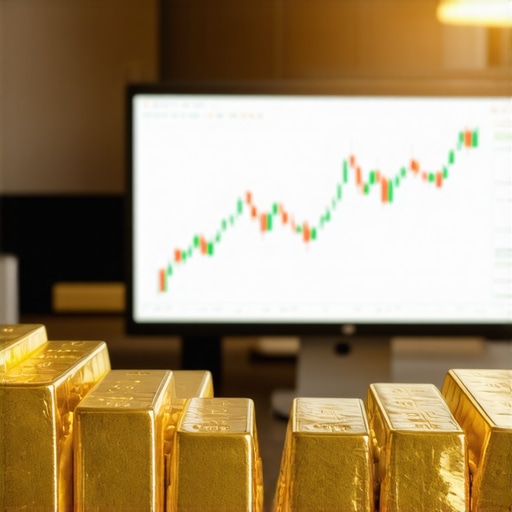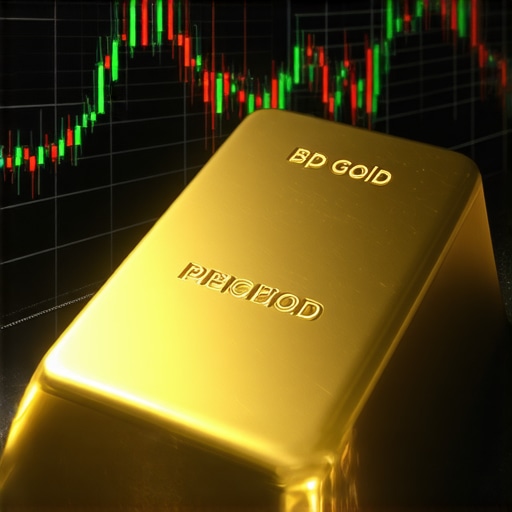Gold Price Forecast 2025: An Expert Analysis of Macroeconomic Drivers
The trajectory of gold prices in 2025 is shaped by an intricate interplay of global economic factors, geopolitical tensions, and evolving market dynamics. As an asset revered for its intrinsic value and inflation-hedging properties, gold continues to attract sophisticated investors seeking portfolio diversification and risk mitigation. This analysis delves into the critical forces influencing gold’s valuation, enabling investors to strategically position themselves for the upcoming market landscape.
Decoding Inflationary Pressures and Central Bank Policies Impacting Gold
Persistent inflationary trends worldwide have intensified central banks’ monetary policy adjustments, notably interest rate hikes and quantitative tightening. These measures directly affect real yields, often inversely correlating with gold prices. The Federal Reserve’s trajectory, alongside the European Central Bank and People’s Bank of China, remains pivotal. Understanding these monetary policy nuances is essential for anticipating gold price fluctuations, as gold serves as a non-yielding asset whose appeal rises when real yields decline.
Supply Constraints and Mining Sector Challenges: A Hidden Catalyst?
Beyond macroeconomic indicators, physical supply factors significantly influence gold pricing. Mining output has faced headwinds due to declining ore grades, rising extraction costs, and regulatory interventions in key producing regions. These supply constraints, coupled with geopolitical risks in resource-rich countries, may induce tighter market conditions. Investors should monitor reports on mining production trends and central bank purchases, which can signal shifts in supply-demand equilibrium.
How Will Emerging Technologies and Industrial Demand Alter Gold’s Market Dynamics by 2025?
Advancements in technology sectors such as electronics and medical devices are incrementally increasing industrial gold demand, potentially altering traditional demand patterns dominated by jewelry and investment. The integration of gold in high-precision applications and green technologies could contribute to sustained physical demand, offsetting some investment-driven volatility. This structural demand evolution demands close observation for its long-term pricing implications.
Strategic Implications for Investors: Balancing Gold Holdings Amid Volatility
Given the multifaceted influences on gold prices, investors must adopt nuanced strategies combining physical bullion, ETFs, and selective mining stocks to optimize risk-adjusted returns. Diversification within gold investment vehicles can mitigate specific risks related to liquidity and counterparty exposure. For those interested in advanced portfolio tactics, resources such as smart gold investment strategies balancing coins and ETFs offer detailed guidance.
Investors looking to deepen their understanding of gold market mechanics and nuanced price forecasts are encouraged to explore key gold price forecast trends for 2025, which provide data-driven insights and expert perspectives.
For authoritative market analyses, the World Gold Council’s comprehensive reports remain indispensable, offering empirical data and forecasts underpinning gold’s fundamental valuation. For instance, their 2024 Gold Demand Trends report elucidates shifting investment and industrial consumption patterns, accessible at World Gold Council.
Evaluating the Role of Geopolitical Risks in Gold Price Movements
Geopolitical tensions continue to be a significant driver of gold price volatility, acting as a catalyst for sudden demand shifts. Conflicts, trade disputes, and regional instability often propel investors toward gold as a safe haven, temporarily decoupling its price from fundamental economic indicators. Notably, global hotspots such as Eastern Europe, the Middle East, and the South China Sea remain key areas to monitor for their potential to disrupt supply chains and financial markets alike.
Moreover, central banks’ strategic gold purchases in response to geopolitical uncertainties can bolster prices. For instance, recent increases in gold reserves by emerging economies demonstrate a hedging strategy against currency risk and geopolitical shocks. Investors should incorporate geopolitical risk assessment into their gold market analysis to anticipate and capitalize on price spikes driven by such factors.
Innovations in Gold Trading: Leveraging Technology for Enhanced Market Navigation
The adoption of advanced trading algorithms and artificial intelligence has transformed gold market participation, enabling real-time analysis of market sentiment, price momentum, and macroeconomic signals. Sophisticated traders employ machine learning models to detect subtle correlations between gold prices and alternative data sources such as social media trends, satellite imagery of mining operations, and global economic indicators.
These technological advancements facilitate more precise entry and exit timing, risk management, and portfolio rebalancing. Investors interested in harnessing these tools may benefit from exploring advanced gold trading techniques for smart market moves that detail algorithmic strategies and AI integration.
What Are the Emerging Risks and Opportunities in Gold Mining Stocks for 2025?
Gold mining stocks present a nuanced risk-reward profile influenced by operational efficiency, geopolitical exposure, and commodity price cycles. While mining equities often provide leveraged exposure to gold prices, they also carry company-specific risks such as management performance, environmental regulations, and labor disputes.
Emerging trends include increased ESG (Environmental, Social, and Governance) compliance pressures which may affect operational costs but also open access to sustainable investment funds. Furthermore, exploration successes or setbacks can dramatically shift valuations. Investors should conduct thorough due diligence, considering both macroeconomic factors and micro-level company fundamentals. For those looking to enhance their mining stock knowledge, the top gold mining stocks to watch for high returns in 2025 provide a curated list with expert insights.
Integrating Gold Investment into a Holistic Portfolio Strategy
Incorporating gold into a diversified investment portfolio requires a balance between physical assets, exchange-traded funds (ETFs), and equities tied to the gold ecosystem. Physical gold offers security and liquidity but involves storage and insurance considerations, whereas ETFs provide ease of trading and cost efficiency at the expense of direct ownership.
Mining stocks and mutual funds add growth potential but also volatility. A strategic allocation, tailored to individual risk tolerance and investment horizon, can optimize portfolio resilience amid economic uncertainty. To build such a balanced approach, investors may find valuable guidance in how to build a balanced gold ETF portfolio for future gain.
We invite readers to share their own experiences or questions regarding gold investment strategies in the comments below, fostering a community of informed and proactive investors.
For a comprehensive understanding of gold’s diverse investment avenues, consider reviewing the Investopedia’s expert guide on gold investment methods, which complements our analysis with practical perspectives.
ESG Integration in Gold Mining: Transforming Risk Profiles and Investment Returns
Environmental, Social, and Governance (ESG) criteria have emerged as pivotal determinants in the valuation and operational strategies of gold mining companies. The push towards sustainable mining practices is not merely regulatory compliance but a strategic repositioning to attract capital from increasingly conscientious investors. ESG-focused funds and institutional investors now prioritize companies with transparent governance, responsible environmental stewardship, and proactive community engagement, thereby reshaping the investment landscape.
Implementing rigorous ESG standards often involves upfront capital expenditures, such as adopting renewable energy sources for mining operations or enhancing waste management systems. While these costs can initially depress profitability, they mitigate long-term operational risks—including regulatory penalties and reputational damage—ultimately fostering a more resilient business model. Moreover, miners with strong ESG credentials may gain preferential access to capital markets, benefiting from lower borrowing costs and heightened investor confidence.
Investors evaluating mining stocks must thus incorporate ESG metrics into their due diligence frameworks. Tools like the Sustainalytics ESG Risk Ratings and MSCI ESG Ratings provide granular assessments of mining companies’ performance across these domains. For example, Newmont Corporation’s leadership in reducing carbon emissions and fostering indigenous community partnerships exemplifies how ESG integration can enhance both social license to operate and shareholder value (Newmont Sustainability Report 2023).
Harnessing AI-Driven Sentiment Analysis for Predictive Gold Price Insights
Artificial intelligence (AI) and natural language processing (NLP) techniques have revolutionized market sentiment analysis, providing investors with an unprecedented edge in forecasting gold price movements. By analyzing vast datasets—including news articles, social media chatter, and policy announcements—AI models can quantify market sentiment shifts that precede price volatility.
For instance, machine learning algorithms trained on historical gold price data and correlated geopolitical event patterns enable real-time risk assessment. These models can detect subtle changes in sentiment polarity or volume spikes in gold-related discussions, signaling potential market inflection points. Coupling sentiment analysis with traditional technical indicators enhances predictive accuracy, empowering traders to optimize entry and exit points.
One cutting-edge approach involves integrating satellite imagery data of mining activity with sentiment signals to refine supply-side forecasts. This fusion of alternative data sources exemplifies the sophisticated analytics now accessible to institutional and savvy retail investors alike.
How Can Investors Effectively Combine ESG Metrics and AI Tools to Optimize Gold Mining Stock Portfolios?
Integrating ESG assessments with AI-driven market analytics offers a holistic framework for managing gold mining stock portfolios amid 2025’s complexities. Investors should first establish ESG screening criteria aligned with their risk tolerance and ethical considerations. Subsequently, leveraging AI platforms capable of sentiment analysis and predictive modeling allows dynamic portfolio adjustments responsive to emerging news and market signals.
This dual-pronged approach helps identify mining stocks with sustainable operations and favorable near-term price catalysts, balancing long-term resilience with tactical agility. Additionally, scenario analysis models can simulate the impact of regulatory changes or geopolitical events on ESG compliance and market sentiment, further informing investment decisions.
For detailed methodologies on synthesizing ESG data with AI analytics, the World Gold Council’s research on advanced analytics in mining investment offers in-depth insights.
Deciphering the Interplay of Currency Fluctuations and Gold as a Safe Haven Asset
The gold price’s sensitivity to currency exchange rates, especially the US dollar, remains a cornerstone of market dynamics. Generally, a weakening dollar enhances gold’s appeal to holders of other currencies, as it lowers the relative price and increases purchasing power. However, this relationship can be nuanced by cross-border capital flows and divergent monetary policies.
Furthermore, in times of heightened financial uncertainty, gold’s status as a safe haven often supersedes typical currency correlations. For example, during episodes of currency crises or sovereign debt distress, demand surges irrespective of prevailing dollar trends. Investors should thus analyze macroeconomic indicators alongside foreign exchange market volatility to anticipate gold price movements effectively.
Advanced hedging strategies incorporating currency derivatives and gold instruments can be deployed to manage exposure. Combining these tools with macroeconomic scenario planning enhances portfolio robustness in fluctuating environments.
To deepen expertise on currency-gold interrelations, the International Monetary Fund’s detailed analysis on “Gold and Currency Markets” provides authoritative guidance (IMF Working Paper, 2020).
Leveraging ESG and AI Synergies for Cutting-Edge Gold Investment Strategies
As gold investment paradigms evolve, the confluence of Environmental, Social, and Governance (ESG) frameworks with artificial intelligence-driven analytics is pioneering new frontiers in portfolio optimization. Investors are increasingly adopting hybrid methodologies that synthesize ESG risk assessments with real-time AI sentiment evaluations to discern both long-term sustainability and immediate market catalysts in gold assets and mining equities.
This integrated approach enhances the precision of risk-adjusted returns by systematically filtering companies excelling in corporate responsibility while simultaneously capturing transient price signals triggered by geopolitical or macroeconomic developments. The World Gold Council’s detailed exposition on advanced analytics in mining investment elucidates practical frameworks to amalgamate these datasets effectively, empowering investors to navigate the 2025 gold landscape with unprecedented agility.
How can AI-enhanced ESG analysis transform risk management and alpha generation in gold mining portfolios?
AI-enhanced ESG analysis revolutionizes risk management by automating the continuous monitoring of ESG disclosures, social media sentiment, and regulatory changes, thereby enabling early identification of operational or reputational risks that traditional analysis might overlook. This proactive insight facilitates timely portfolio rebalancing to mitigate downside exposure.
Concurrently, by harnessing machine learning algorithms trained to detect positive ESG momentum alongside favorable market sentiment, investors can identify alpha-generating opportunities where sustainable practices correlate with superior financial performance. This dual capability fosters a dynamic yet resilient investment posture, marrying ethical imperatives with sophisticated quantitative strategies.
The Intricate Nexus Between Currency Volatility and Gold’s Safe Haven Status
Understanding the nuanced interaction between fluctuating currency values—particularly the US dollar—and gold’s role as a refuge asset is paramount for sophisticated market participants. While a depreciating dollar generally augments gold’s attractiveness internationally, this correlation is modulated by cross-border capital flows, divergent monetary stances, and episodic financial crises that can decouple traditional relationships.
Advanced hedging tactics incorporate currency derivatives alongside gold instruments to construct multi-dimensional risk buffers, optimizing portfolios against concurrent FX and commodity price shocks. Strategic scenario analyses, embedding variables such as sovereign debt distress or currency regime shifts, provide a comprehensive vista for anticipating gold price trajectories amidst complex global financial interdependencies.
For a rigorous exploration of these dynamics, the IMF Working Paper on Gold and Currency Markets offers an authoritative resource detailing empirical relationships and policy implications.
Emerging Frontiers in Gold Market Analytics: Satellite Data and Alternative Intelligence
Beyond conventional datasets, the incorporation of satellite imagery and alternative data streams is redefining supply-side intelligence in gold markets. Monitoring mining site activity through high-resolution satellite images provides near real-time insights into operational scale, production disruptions, and environmental compliance, which complement traditional reporting mechanisms.
When fused with AI-driven sentiment analysis and macroeconomic indicators, these multidimensional analytics enable investors to anticipate supply shocks and demand shifts with greater granularity, thus refining price forecasting models. This innovative data synthesis is particularly valuable amid geopolitical uncertainties affecting mining regions, where transparency and timely information confer decisive investment advantages.
Investors and analysts are encouraged to explore emerging platforms that integrate these alternative data sources to remain at the vanguard of gold market intelligence.
Engage with these advanced perspectives to elevate your gold investment acumen and harness innovative tools that shape tomorrow’s market outcomes.
Expert Insights & Advanced Considerations
Gold’s Price Sensitivity to Macro-Volatility Requires Adaptive Strategies
The intricate relationship between inflationary pressures, central bank policies, and geopolitical risks continues to challenge traditional gold valuation models. Investors must remain agile, employing diversified exposure across physical bullion, ETFs, and mining equities while monitoring real yields and currency fluctuations closely. Embracing technological innovations such as AI-driven sentiment analysis can provide a decisive edge in navigating market volatility.
Integrating ESG Metrics with AI Analytics is the Future of Mining Stock Evaluation
ESG compliance is no longer a peripheral concern but a core determinant of mining companies’ long-term viability and investor appeal. When combined with AI-powered market intelligence, ESG data enhances risk management by anticipating operational disruptions and reputational risks. This fusion enables sophisticated investors to identify alpha opportunities grounded in sustainable corporate practices, aligning financial performance with ethical imperatives.
Supply-Side Constraints Amplify Gold’s Safe Haven Role Amid Geopolitical Uncertainty
Declining ore grades, regulatory hurdles, and geopolitical instability in key mining regions accentuate supply risks that support sustained gold demand as a safe haven asset. Central bank accumulation of reserves underlines gold’s strategic importance in currency risk mitigation. Investors should consider these fundamentals alongside emerging industrial demand from high-tech applications to capture nuanced market shifts.
Advanced Data Sources Like Satellite Imagery Redefine Market Intelligence
Incorporating alternative data streams such as satellite monitoring of mining activity offers near real-time insights into production trends and environmental compliance. When synthesized with AI sentiment models and macroeconomic indicators, this multidimensional approach enhances forecasting precision and enables proactive portfolio adjustments before traditional metrics reflect changes.
Curated Expert Resources
World Gold Council’s Gold Demand Trends 2024: An authoritative source offering empirical data on evolving investment, industrial, and central bank gold consumption patterns, essential for comprehensive market analysis.
IMF Working Paper on Gold and Currency Markets (2020): Provides rigorous examination of gold’s interplay with global currency fluctuations and policy impacts, critical for understanding safe haven dynamics.
Advanced Gold Trading Techniques for Smart Market Moves: This resource details algorithmic and AI-driven strategies enabling investors to leverage cutting-edge analytics for tactical advantage.
Top Gold Mining Stocks to Watch for High Returns in 2025: Curated insights on mining equities, integrating operational, ESG, and geopolitical factors to identify promising investment candidates.
How to Build a Balanced Gold ETF Portfolio for Future Gain: Offers practical guidance on constructing diversified portfolios that balance risk, liquidity, and growth potential within the gold ecosystem.
Final Expert Perspective
Gold price forecasting for 2025 demands a synthesis of multifaceted macroeconomic, geopolitical, and technological considerations. The convergence of ESG integration and AI-enhanced analytics is reshaping how investors evaluate gold assets and mining equities, fostering more resilient and agile investment approaches. Understanding supply constraints alongside evolving demand drivers—especially in technology and central bank behavior—provides a nuanced framework for anticipating price trajectories. We encourage readers to deepen their expertise through the advanced resources highlighted and to engage actively by sharing insights or exploring strategic gold investment methodologies such as those found in smart gold investment strategies and advanced gold trading techniques. Staying informed and adaptive will be paramount in capitalizing on the complexities of the 2025 gold market landscape.










